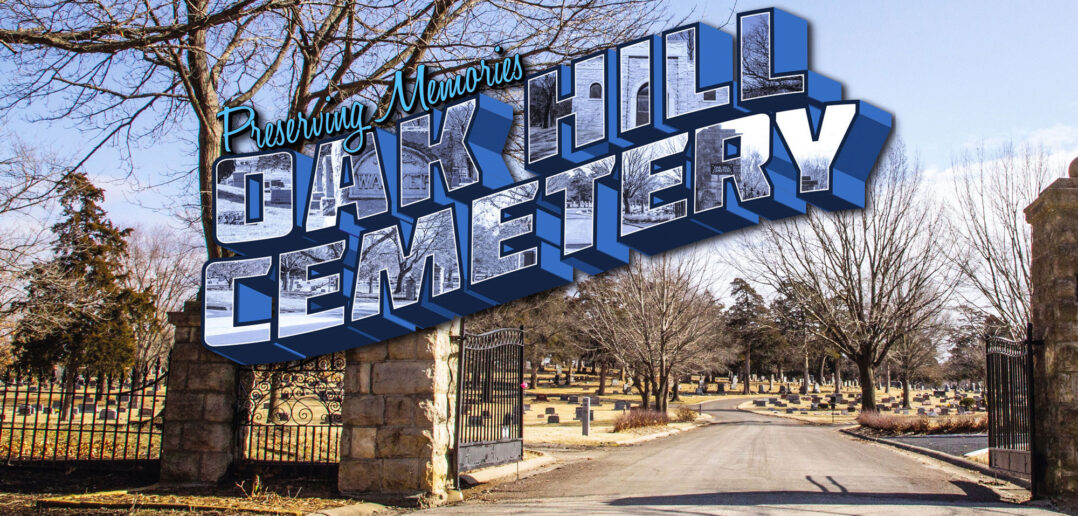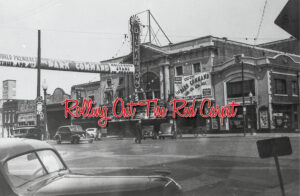| story by | |
| photos by | Steven Hertzog |
| OPEN A PDF OF THE ARTICLE |
 Because urban cemeteries often were overcrowded, cities across the country began to move them a few miles outside of town in parklike settings.
Because urban cemeteries often were overcrowded, cities across the country began to move them a few miles outside of town in parklike settings.
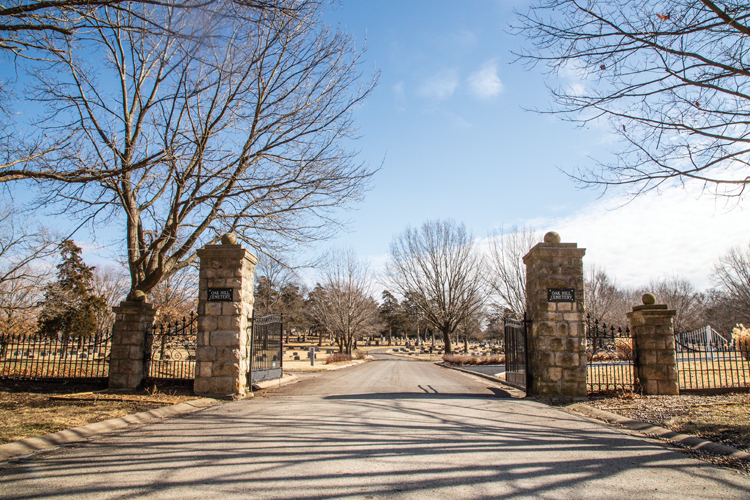
Oak Hill Cemetery
In his inaugural address in 1864, Mayor R. W. Luddington called for a new cemetery to serve as a site with “sepulchral fitness for sacred reminiscences where departed friends could be remembered.” It was to replace Pioneer Cemetery, which was a distance from town and contained the remains of victims of the 1863 raid by William Quantrill and his guerrillas. As a result, the city of Lawrence purchased land for what became Oak Hill Cemetery in 1865 and authorized Mayor Gurdon Grovenor to look for a professional landscaper. In the meantime, Holland Wheeler, and engineer hired by the City, platted the site, and the City sold 250 lots, with the proceeds being used to pay for surveying and fencing the property.
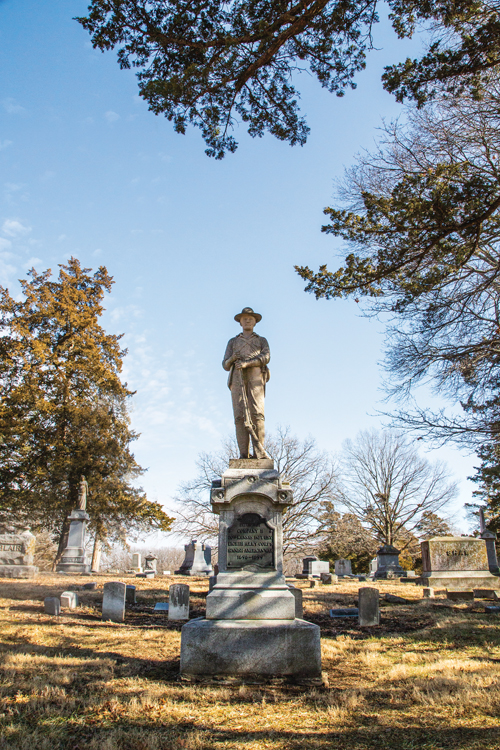
Oak Hill Cemetery
The cemetery was to be designed on the “rural cemetery ideal,” which had been popular in eastern cities because of the effects of industrialization—smoke, grime and pollution of all sorts. Urban cemeteries with limited room to expand were overcrowded, and graves were sometimes stacked on top of each other. Rural cemeteries were typically built one to five miles outside of the city, far enough to be separated from the city but close enough for visitors. They often contained elaborate monuments, memorials and mausoleums in a landscaped parklike setting. The rural cemetery movement mirrored changing attitudes toward death. Images of hope and immortality were popular, and statues and memorials included depictions of angels and cherubs, as well as botanical motifs such as ivy representing memory, oak leaves for immortality, poppies for sleep and acorns for life.
For Oak Hill Cemetery, this meant creating that desired parklike setting. However, an article in the Daily Kansas Tribune on March 26, 1870, pointed out the City’s failure to meet that goal:
While it is true that nature has lent many charms to the site selected, and individual taste and affection contributed to its adornment, the grounds still lack the improvement which the friends of the beloved dead should have bestowed on them. We do not want to find fault with our City Council. They have done much of the past year’s work well, and deserve commendation for many things. But it seems to us that there might be more attention paid to the cemetery. Individual effort might be made to a greater and better purpose, and the city ought to spend more money in laying out the walks and planting trees. As this is the season of tree-planting, the suggestion, we think, is not inappropriate, that every person having a relative reposing there should plant a tree.
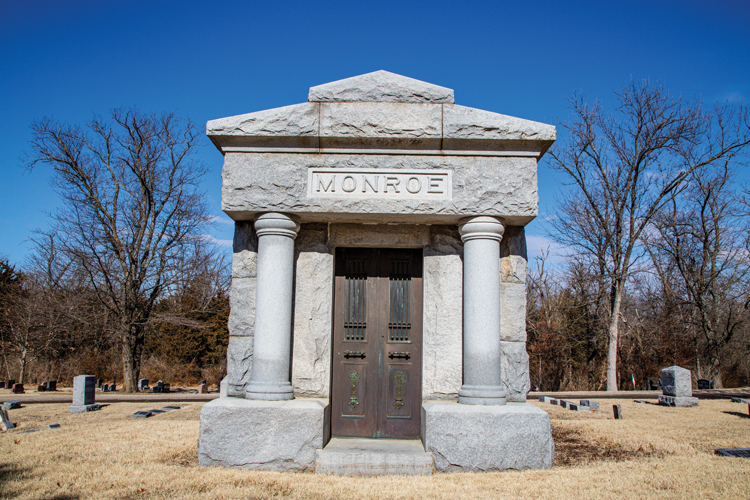
Oak Hill Cemetery
Evidently, the City took notice. The next spring, Grovenor, former mayor and then cemetery superintendent, placed an ad in the Daily Kansas Tribune for 75 elm trees for Oak Hill Cemetery.
The cemetery has several connections to Quantrill’s Raid. Many of those who died were buried in a trench on Mount Oread called the long grave. In 1872, the City of Lawrence decided to reinter these raid victims to Oak Hill Cemetery. Others killed in the raid were buried in various places throughout Lawrence. Mayor Grovenor invited the families of these victims to be reburied in Oak Hill Cemetery, as well. On May 30, 1895, the Quantrill’s Raid Memorial was dedicated. The inscription on one side of the granite monument reads: “Dedicated to memory of the one hundred and fifty citizens who defenseless fell victims to the inhuman ferocity of border guerrillas led by the infamous Quantrell [sic]in his raid upon Lawrence, August 21st, 1863.” The other side’s message was: “The roll of their names may be found in the city Clerk’s office Lawrence. And in the records of the State Historical Society, Topeka.”
Oak Hill Cemetery was integrated from its inception. This is not surprising given the abolitionist sentiments of the City’s founders. For a time, the Daily Kansas Tribune printed the names of those receiving permits for burial. The notice in the Jan. 30, 1870, edition indicated that “burial permits were issued for the interment in Oak Hill Cemetery of Etta B Ellis, aged 4 months; Fannie Bowers (colored).” Gabriel Gray, an African American minister, was one of the early burials. Jesse and Frances Dillard, African Americans who lived in the Pinckney neighborhood, were also buried in Oak Hill. Charles and Mary Langston, the grandparents of Langston Hughes who raised him during his time in Lawrence, are buried in Oak Hill Cemetery. In Section 4 of the cemetery, there are graves of veterans of the 79th and 83rd United States Colored Troops. All of these burials are interspersed among the graves of white Lawrencians.
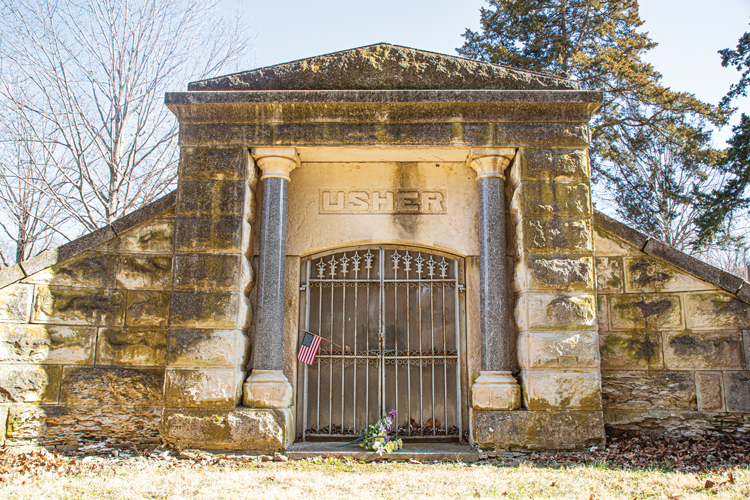
Oak Hill Cemetery
In the years following the Civil War, Decoration Day was established to honor those who died fighting for their country during this conflict. A proclamation of Gen. John A. Logan of the Grand Army of the Republic (GAR) in 1868 stated that the first major Memorial Day observance was held to honor those who died “in defense of their country during the late rebellion.” Known as “Decoration Day,” mourners honored the Civil War dead by decorating their graves with flowers. On the first Decoration Day, Gen. James Garfield made a speech at Arlington National Cemetery, after which 5,000 participants helped to decorate the graves of the more than 20,000 Civil War soldiers buried in the cemetery. This built on a pre-Civil War tradition of decorating graves of family members in the spring.
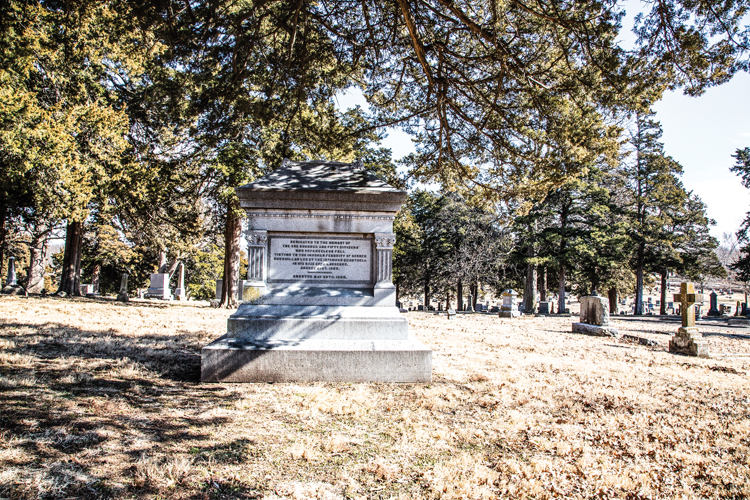
Oak Hill Cemetery
In the 1870s and 1880s, Decoration Day observances in Lawrence were elaborate. According to the “Order of Exercises,” arranged by the Lawrence GAR post and printed in the May 28, 1871, Daily Kansas Tribune, at 12 noon: “one hundred guns will be fired from Oak Hill cemetery, all bells of the city will be tolled for thirty minutes, all steam whistles blown, all flags displayed at half mast, and the band will discourse a dirge from the headquarters of this Post.” At 3 p.m., a procession was to be formed by various groups to go to Oak Hill Cemetery. Those participating in the parade included a mounted escort of Knights Templar, orators of the day, the band, G.A.R. and all other soldiers and sailors, city government, fire department masonic fraternity, Odd Fellows, Good Templars, Turnverein Society, University cadets, all other organizations, citizens on foot, citizens mounted and citizens in carriages. The memorial program was to begin at 4 p.m. with an anthem by the choir and a prayer by the Rev. Richard Cordley. The program included speeches by T. D. Thatcher, Gen. John Fraser, the Rev. N. S. Sage and I. S. Kalloch. The orations were interspersed with musical numbers including the “Star-Spangled Banner” and “America.” The decoration of graves followed the program, and the event concluded with a benediction by the Rev. F. M. Ellis. Similar Memorial Day programs were organized for the following years.
Oak Hill Cemetery became one of the attractions for visitors to Lawrence. The Daily Kansas Tribune for May 9, 1881, described the cemetery as follows:
Oak Hill Cemetery is situated half a mile east of the city limits. A high mound forms the center of the grounds, taking a gradual slope in every direction. This is arranged into terraces, covered with blue-grass and ornamented with shade trees. At the summit of the mound is the flower garden, appearing in summer, like one vast bouquet of choice flowers. A few yards west of this is a fine marble shaft, marking the resting place of Gen. James H. Lane. At the eastern extremity of the grounds are buried the heroes of the Lawrence massacre. … Much attention is bestowed by the city upon its cemetery, especially upon Decoration Day.
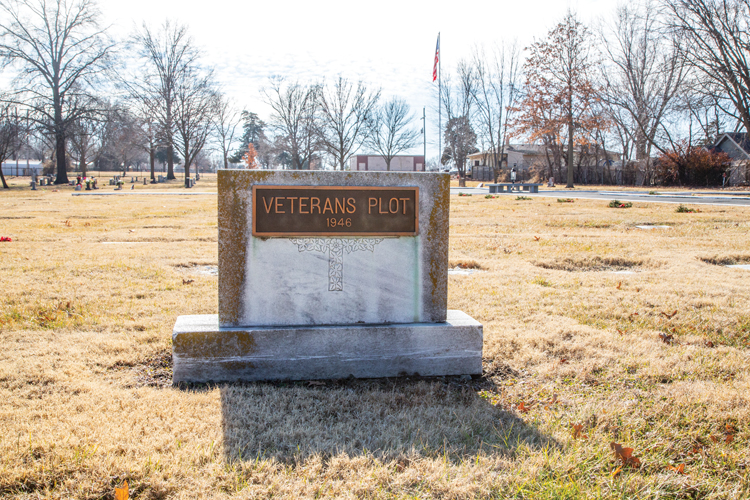
Oak Hill Cemetery
So many well-known people are buried in Oak Hill Cemetery, journalist William Allen White called it the “Kansas Arlington.” The first governor of Kansas, Charles Robinson, and his wife, Sarah, are buried there. The graves of early Lawrence activists include James H. Lane, James Blood, Richard Cordley, James Emery, Wilson Shannon and John Speer. Lucy Taylor, the first woman dentist in Kansas, is interred in Oak Hill. The cemetery includes several mausoleums including one for John Usher, Secretary of the Interior under President Abraham Lincoln. The graves of Lawrence businessmen Justin Bowersock and Jabez Watkins are in the cemetery. Prominent Kansas University basketball coach Forrest “Phog” Allen is buried in Oak Hill, as well, along with many other notables.
Oak Hill Cemetery is a peaceful place that illustrates the goals of the rural cemetery movement with its rolling terrain. If explored in detail, it presents a look at the people who founded Lawrence and made it a prosperous city. Oak Hill Cemetery is located on East 15th Street and Oak Hill Avenue, and can be accessed from Elmwood Street.

